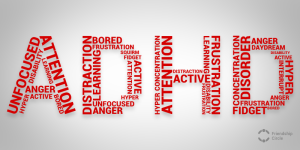The Basics of ADHD

Attention Deficit Hyperactivity Disorder (ADHD) affects nearly 8% of all children in the U.S. But we’re not the only ones.  Climate seems to be the only ameliorating factor. Incidence of ADHD is lowest in areas with a higher solar index, that is, a sunny climate. This applies both inside and outside the U.S.
The frequency of diagnosis as well as the prevalence of American research has led to the assumption that Attention Deficit Hyperkinetic Disorder is largely an “American disorder,” stemming from behaviors and cultural norms not found in other cultures. But in a study of the “Worldwide prevalence of ADHD” published in 2003, Stephen V. Faraone and his investigative team conclude that this is not the case.
After identifying 50 studies of ADHD worldwide (20 based on U.S. populations and 30 based on non-U.S. populations), Faraone et al conclude that the prevalence of ADHD is at least as high in many non-US children as in US children with the highest prevalence being seen when the DSM-IV diagnoses are used.
We may be hearing about it now in record proportions but ADHD is not new. The first case of what appears to be ADHD was reported by the Scottish physician Sir Alexander Crichton in 1798. Earlier descriptions may be lost to us simply because mental issues were not discussed from a physiological perspective prior to the 19th century. Even today the connection between mental and physical health is not always fully understood or appreciated.
Self control in children has long been associated with obedience, an aspect of morality that grows with the child’s perception of the rights of others and the importance of societal norms. In 1844 the German physician Heinrich Hoffmann created the character of “Fidgety Phil†as a cautionary tale about a little boy who can’t sit still and brings the dinner table down on himself and his family. His book was meant to entertain and instruct but the underlying message is clear. Fidgeting means trouble for you and your family: Get over it!
Today we recognize that many children just can’t get over it. Medical Resonance Imaging (MRI) has added greatly to our understanding of brain structure and function. Because MRI does not involve exposure to ionizing radiation, it enables us to see and study the developmental differences between the typical and the ADHD brain. These images indicate that, in addition to improving behavior, psycho-stimulant medications can help normalize brain development.
Won’t They Outgrow It? Children are naturally active, even hyperactive. Some mature more slowly than others. Why not let nature take its course and wait for so-called “hyperactives†to catch up with their peers?
But what if they don’t? Some children do outgrow ADHD. Their symptoms recede in late adolescence, but the effects of the disorder remain, both physically and psychologically.  It doesn’t take a lot of imagination to realize that the experience of being the “class clown,†the kid who can’t sit still, will affect the child’s self image and travel with him into adulthood. For example see:  Social-and-Emotional-Impairment-in-Children-and-Adolescents-with-ADHD-and-the-Impact-on-Quality-of-Life
The long-term physical effects are still being explored. Untreated, the ADHD brain grows and develops more slowly ending with a decreased volume of grey matter. Psycho-stimulants can restore the deficit. Recent studies suggest that these medications improve behavior by normalizing the chemistry of the brain by increasing dopamine and, in some cases, norepinephrine in the synapse.  The normalized chemistry results in near normal amounts of grey matter . Researchers believe that these brain effects parallel and underlie the widespread clinical benefits.
Not Just Kids’ Stuff. ADHD can persist to adulthood as well. Estimates vary widely –from 35-85% with estimates being highest for those who were not treated in childhood. In adulthood symptoms change from hyperactivity to more sophisticated issues of attention and impulse control. Inattentiveness, misplacing items, and procrastination can substantively impair performance and reduce earing power recently estimated at between roughly $90 Billion and $140 Billion per year.  This issue has become substantial enough to generate commentary in the Wall Street Journal (Young Workers With Dyslexia, ADD Find Office Less Accommodating Than School October 12, 2006; Page D1 Sue Shellenbarger).  Currently ADHD is believed to affect 10% of children and 5% of adults worldwide.
Safety: For many years physicians and opinionated members of the media and some social organizations debated the effects of potential cardiovascular effects of stimulants. Many of the studies were small and frequently repudiated by major medical organizations. Finally, the FDA decided to conduct a thorough investigation. Note that the studies were not sponsored by industry. They conducted two studies, one in children and young adults and one in Adults  Both studies showed that the use of stimulants did not increase the risk of serious cardiovascular events compared to non-users. In fact, when the incidence of events in non-users was normed to 1, the incidence in users was 0.75 in the first study and 0.81 in the second. That is the incidence in those using stimulants was lower than that in those not using stimulants. These were huge studies with the first comprising about 2.5 million patient-years and the second about 800,000 patient-years.


